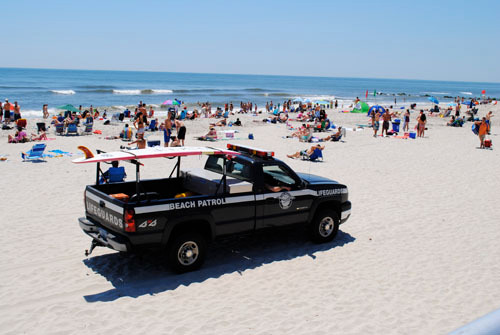Long Beach kids respect ocean’s power
Officials explain why locals don't drown
Over the past two weeks, there have been more than 20 rescues of distressed swimmers in Long Beach waters, according to Chief of Lifeguards Paul Gillespie, who noted that none of the swimmers involved were Long Beach residents.
"The people coming here don't understand the power of the ocean," Gillespie said, adding that, in his opinion, 80 percent of Long Beach youths are water-smart, with a deep respect for the ocean they grew up near.
Starting with a particularly hot May, Gillespie said that the beaches have been extra busy, despite the fact that they do not open full-time until the end of this month. The guards who are on the beach during the week, Gillespie explained, are preparing it for the upcoming season, and are not on patrol. "We don't have enough staff to have the [guards] up early," he said.
The city's fire commissioner, Scott Kemins, who said he worked as a lifeguard for 29 years, described the inevitable preseason rescues as frustrating. "You watch these kids, for lack of a better term, committing suicide," he said. "It frustrates you."
On May 29, the body of Emanuel Tiburcio, 19, of Brooklyn, washed up in Atlantic Beach, three days after he drowned in the waters off Edwards Boulevard. Rescue crews used boats and helicopters to search for Tiburcio on a day when some 10 other people needed to be rescued.
The City posts signs warning beachgoers that swimming is prohibited when lifeguards are not on duty, and police patrol the sand, but officials said that it is nearly impossible to keep people out of the water. Gillespie said that most of the preseason or off-hours rescues occur in the middle of town, near Long Beach, National, Riverside and Edwards boulevards because of their proximity to the Long Beach Bridge and the Long Island Rail Road station. He added that there are rarely rescues in the East or West End because locals frequent those beaches.
Asked why Long Beach youths seldom seem to get in trouble in the ocean, Kemins said he believes they are taught the basics of water safety when they are young. Kemins, a lifelong resident, said that his twin daughters were introduced to the water at six months of age.
Gillespie said that the ever-increasing number of children who are learning to surf are made aware early of the ocean's potential dangers. "In the past 20 years ... the surfing has gone through the roof," he said. Long Beach has two surf schools in which kids are taught not only how to ride a board, but to respect the ocean's power.
Arnold Epstein, director of athletics, phys. ed. and health at the Long Beach School District, said that the schools offer a unique program that teaches second-graders how to swim and includes beach safety. The 10-week program is offered to all children, and they are bused to the high school once a week.
"In the program, it's not just about teaching kids how to swim," said Epstein. Children also learn when it is safe to go in the water and general safety rules, like swimming only with adult supervision.
When the students enter middle school, those rules are reinforced with a beach safety presentation. Vice Principal Michelle Natale spearheaded the program three years ago when she saw students and teachers coming back from the Memorial Day break sporting sunburned skin.
Mike Lundwall, a sixth-grade teacher and city lifeguard, includes video in his water safety presentation that teaches kids about rip currents and how to swim out of them. Lundwall also offers information on how to translate lifeguards' whistle and hand signals. For example, two short whistle blasts are meant to alert a swimmer; three are for fellow lifeguards. "The kids were at the ends of their seats the whole time," said Natale.
Tony Chryseliou, a longtime resident, has a 12-year-old son who he feels is very cautious around the water. Chryseliou, who moved to Long Beach when he was 9, said he always stressed a need to respect the power of the ocean. Now that his son is nearly 13, Chryseliou said, he hopes he has learned the same lessons. "It's kind of scary," he said. "I have to learn to trust him and trust the lifeguards."
Chryseliou is unsure how to keep people out of the water without regulating every human behavior. "There's no practical solution," he said. "It's frustrating as a human being to have someone needlessly die."
Diane Fitch, who has called the barrier island home for more than 50 years, suggested posting more signs by the train station, but she admitted that there is no way to keep people from doing what they want. "It's a terrible thing that almost every year we have to start our season like this," she said.
Asked what else the city could do, Kemins said with an exasperated sigh, "Short of trying to block the Atlantic Ocean? I just don't know."
Comments about this story? JKellard@liherald.com or (516) 569-4000 ext. 213.

 64.0°,
Mostly Cloudy
64.0°,
Mostly Cloudy 




